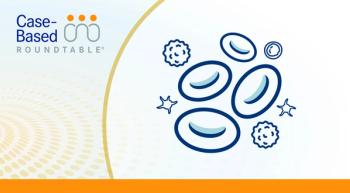
Scenario 1: Optimizing Management of Acute GVHD
Experts review the prognosis of a patient with acute graft-versus-host disease and identify ways to optimize their treatment strategies.
Episodes in this series

Transcript:
Nelson Chao, MD: I think the data flowing from the phase 3 trial with ruxolitinib [Jakafi] supports this over the best alternative therapy. Just to remind everybody, like Dr Cutler said, each institution has their preference. So there were 10 other choices for the best alternate therapy that wasn’t the trial. She was starting ruxolitinib 5 mg twice a day. She tolerated this well. The dose was then increased [to] 10 mg twice a day at day 3. What is the prognosis for this patient and which clinical pearls would you share to manage acute GVHD [graft-versus-host disease], Dr Cutler?
Corey Cutler, MD, MPH, FRCPC: Well, I would like to say that the prognosis is excellent for this patient. Unfortunately, even though ruxolitinib is our best choice, prognosis still is not fantastic. This patient has slightly greater than 60% likelihood of responding to ruxolitinib by day 28. That response rate falls to 40% by day 56. So while there are some responses by month 2 or 3, some of them unfortunately are lost. That’s better than if we chose non-ruxolitinib therapy in this scenario, where the corresponding numbers are approximately 40% response rate at day 28 and only 20% to 22% by day 56. That being said, even in this trial, ruxolitinib didn’t really improve the overall survival of these patients which was approximately 40% at 2 years. There is a steep drop-off to the survival curve now, with the curves being super imposable in the first few months. There was a slight benefit for ruxoilitinib for the short while but the curves coming together in the long term. So the prognosis isn’t great. It is better than what it used to be. I think we have seen that the overall outcomes for patients, at least with severe graft-versus-host disease, have actually improved overtime. There are a couple of publications that suggest that our outcomes are getting better. I think the explanation for that is both the addition of newer agents, but also our better supportive care that we have for these patients.
More potent and broader antifungal agents, drugs such as letermovir [Prevymis] and valganciclovir [Valcyte], that prevent and treat CMV [cytomegalovirus] and other supportive care measures are a couple of clinical pearls. I think something that people overlook is the supportive care of the acute GVHD patients and what’s required there. So, for example, as Miss Minor said, nutritional support is exceptionally important in these patients, particularly those with gastrointestinal involvement. We generally take a very strict approach to bowel rest when the GI [gastrointestinal] tract is involved, so we allow nothing more than sips of water or isotonic fluids. No more than a few hundred CCs a day, until the patient is really having formed bowel movements again. And that can be weeks. One of the other clinical pearls that I think is important that’s overlooked by many is that while it’s easy to note early responses in the skin, one really can’t guess what’s going on in the intestinal tract. I often will wait 10 to 14 days before declaring failure in the GI tract because until 1 re-epithelizes and regrows villi, then the absorption of water is going to be incomplete. Patients will continue to have watery diarrhea. I’m often concerned that we stack on immunosuppression on patients who are actually destined to respond to line therapy. And I worry that we do that a little bit early. So my 2 pearls for the management of GI GVHD are the strict implementation of bowel rest and waiting a sufficient period of time, at least 10 to 14 days, before adding additional immunosuppressive therapy, particularly if the patient is not critically ill.
Nelson Chao, MD: Great. Thank you. I couldn’t agree more. I think one of the things we end up doing with a lot of these patients, which is unfortunate, is we pile on the tremendous amount of immunosuppressants. Plus, we don’t take them down on their steroids 2 mg/kg, and they end up with polypharmacy of immunosuppression and probably increase the risk of other complications significantly.
Transcript edited for clarity.












































